
(a)
Interpretation:
For the given proposed transforms, it is to be determined whether it leads to a synthetic trap (i.e. will not proceed as planned in the forward direction) or not along with the reasoning.
Concept introduction:
A particular reaction is undone by performing a transform that depends on the specific location in the target molecule where we want the changes to occur. In doing so, we may encounter synthetic traps. A synthetic trap is the proposed mechanism that prevents the reaction to occur in the forward direction as planned. From the reactions used for
Answer to Problem 13.6P
The synthesis will proceed as planned. The forward reaction is shown below:
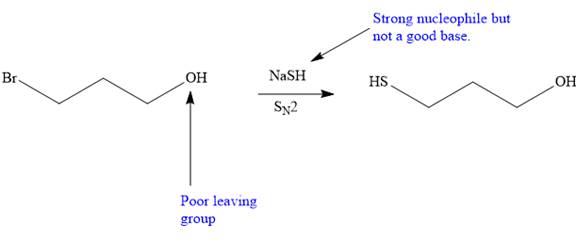
Explanation of Solution
The given proposed transform is:

The target molecule is on the left side. In the target molecule, there are two functional groups present, a cyanide and hydroxyl group. In order to carry out this transform, sodium cyanide (

Thus, the proposed transform does not lead to a synthetic trap and will proceed as planned.
The possibility of the forward reaction in the proposed mechanism is determined on the basis of the functional group transformation reactions, charge stability, and strength of the reagents used.
(b)
Interpretation:
For the given proposed transforms, it is to be determined whether it leads to a synthetic trap (i.e. will not proceed as planned in the forward direction) or not along with the reasoning.
Concept introduction:
A particular reaction is undone by performing a transform that depends on the specific location in the target molecule where we want the changes to occur. In doing so, we may encounter synthetic traps. A synthetic trap is the proposed mechanism that prevents the reaction to occur in the forward direction as planned. From the reactions used for functional group transformation and considering the factors like charge stability and strength of the reagent used, one can determine whether the proposed transform leads to a synthetic trap or not.
Answer to Problem 13.6P
The synthesis will proceed as planned. The forward reaction is shown below:
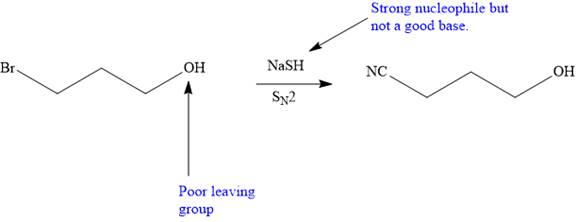
Explanation of Solution
The given proposed transform is:
![]()
The target molecule is on the left side. In the target molecule, there are two functional groups present,
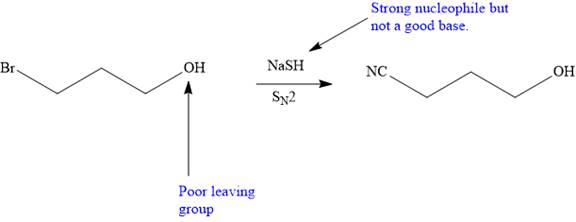
Thus, the proposed transform does not lead to a synthetic trap and will proceed as planned.
The possibility of the forward reaction in the proposed mechanism is determined on the basis of the functional group transformation reactions, charge stability, and strength of the reagents used.
(c)
Interpretation:
For the given proposed transforms, it is to be determined whether it leads to a synthetic trap (i.e. will not proceed as planned in the forward direction) or not along with the reasoning.
Concept introduction:
A particular reaction is undone by performing a transform that depends on the specific location in the target molecule where we want the changes to occur. In doing so, we may encounter synthetic traps. A synthetic trap is the proposed mechanism that prevents the reaction to occur in the forward direction as planned. From the reactions used for functional group transformation, and considering the factors like charge stability and strength of the reagent used, one can determine whether the proposed transform leads to a synthetic trap or not.
Answer to Problem 13.6P
The synthesis will proceed as planned. The forward reaction is shown below:
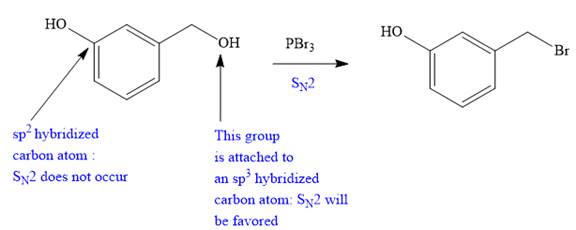
Explanation of Solution
The given proposed transform is:

The target molecule is on the left side. In the target molecule, there are two functional groups present, alkyl halide and hydroxyl group.

Thus, the proposed transform does not lead to a synthetic trap and will proceed as planned.
The possibility of the forward reaction in the proposed mechanism is determined on the basis of the functional group transformation reactions, charge stability, and strength of the reagents used.
(d)
Interpretation:
For the given proposed transforms, it is to be determined whether it leads to a synthetic trap (i.e. will not proceed as planned in the forward direction) or not along with the reasoning.
Concept introduction:
A particular reaction is undone by performing a transform that depends on the specific location in the target molecule where we want the changes to occur. In doing so, we may encounter synthetic traps. A synthetic trap is the proposed mechanism that prevents the reaction to occur in the forward direction as planned. From the reactions used for functional group transformation, and considering the factors like charge stability and strength of the reagent used, one can determine whether the proposed transform leads to the synthetic trap or not.
Answer to Problem 13.6P
The synthesis will not proceed as planned.

The proposed synthesis is a synthetic trap, and the reaction will not proceed as planned in the forward direction.
Explanation of Solution
The given proposed transform is:

The target molecule is on the left side while the proposed reactant molecule is on the right side. In the target molecule, there are two functional groups present, alcohol and alkyl halide. Alkyl halides are prepared from corresponding alcohols when they are treated with phosphorous bromide/chloride in an

The possibility of the forward reaction in the proposed mechanism is determined on the basis of the functional group transformation reactions, charge stability, and strength of the reagents used.
(e)
Interpretation:
For the given proposed transforms, it is to be determined whether it leads to a synthetic trap (i.e. will not proceed as planned in the forward direction) or not along with the reasoning.
Concept introduction:
A particular reaction is undone by performing a transform that depends on the specific location in the target molecule where we want the changes to occur. In doing so, we may encounter synthetic traps. A synthetic trap is the proposed mechanism that prevents the reaction to occur in the forward direction as planned. From the reactions used for functional group transformation, and considering the factors like charge stability and strength of the reagent used, one can determine whether the proposed transform leads to the synthetic trap or not.
Answer to Problem 13.6P
The synthesis will not proceed as planned.

The proposed synthesis is a synthetic trap, and the reaction will not proceed as planned in the forward direction.
Explanation of Solution
The given proposed transform is:
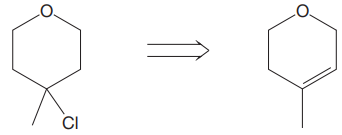
The target molecule is on the left side while the proposed reactant molecule is on the right side. In the target molecule, there are two functional groups present, ether and alkyl halide. Alkyl halides are prepared from
As the reaction does not yield the desired product, we would say that the proposed synthesis is a synthetic trap, and the reaction will not proceed as planned in the forward direction.

The possibility of the forward reaction in the proposed mechanism is determined on the basis of the functional group transformation reactions, charge stability, and strength of the reagents used.
(f)
Interpretation:
For the given proposed transforms it is to be determined whether it leads to a synthetic trap (i.e. will not proceed as planned in the forward direction) or not along with the reasoning.
Concept introduction:
A particular reaction is undone by performing a transform that depends on the specific location in the target molecule where we want the changes to occur. In doing so, we may encounter synthetic traps. A synthetic trap is the proposed mechanism that prevents the reaction to occur in the forward direction as planned. From the reactions used for functional group transformation, and considering the factors like charge stability and strength of the reagent used, one can determine whether the proposed transform leads to the synthetic trap or not.
Answer to Problem 13.6P
The synthesis will not proceed as planned.

The proposed synthesis is a synthetic trap, and the reaction will not proceed as planned in the forward direction.
Explanation of Solution
The given proposed transform is:

The target molecule is on the left side while the proposed reactant molecule is on the right side. In the target molecule, there are two functional groups present,
As the reaction does not yield the desired product, we would say that, the proposed synthesis is a synthetic trap and the reaction will not proceed as planned in the forward direction.

The possibility of the forward reaction in the proposed mechanism is determined on the basis of the functional group transformation reactions, charge stability, and strength of the reagents used.
Want to see more full solutions like this?
Chapter 13 Solutions
Get Ready for Organic Chemistry
- Draw the titration curve of (i) weak acid vs. strong base; (ii) weak acid vs. weakbase; (iii) diprotic acid with strong base (iii) triprotic acid with strong base.arrow_forwardComplete the reaction in the drawing area below by adding the major products to the right-hand side. If there won't be any products, because nothing will happen under these reaction conditions, check the box under the drawing area instead. Note: if the products contain one or more pairs of enantiomers, don't worry about drawing each enantiomer with dash and wedge bonds. Just draw one molecule to represent each pair of enantiomers, using line bonds at the chiral center. More... No reaction. my ㄖˋ + 1. Na O Me Click and drag to start drawing a structure. 2. H +arrow_forwardPredict the intermediate 1 and final product 2 of this organic reaction: NaOMe H+ + 1 2 H H work up You can draw 1 and 2 in any arrangement you like. Note: if either 1 or 2 consists of a pair of enantiomers, just draw one structure using line bonds instead of 3D (dash and wedge) bonds at the chiral center. Click and drag to start drawing a structure. X $ dmarrow_forward
- Predict the major products of this organic reaction: 1. NaH (20°C) 2. CH3Br ? Some notes: • Draw only the major product, or products. You can draw them in any arrangement you like. • Be sure to use wedge and dash bonds where necessary, for example to distinguish between major products that are enantiomers. • If there are no products, just check the box under the drawing area. No reaction. Click and drag to start drawing a structure. G Crarrow_forwardPredict the major products of this organic reaction: 1. LDA (-78°C) ? 2. Br Some notes: • Draw only the major product, or products. You can draw them in any arrangement you like. . • Be sure to use wedge and dash bonds where necessary, for example to distinguish between major products that are enantiomers. • If there are no products, just check the box under the drawing area. No reaction. Click and drag to start drawing a structure. Xarrow_forwardPlease draw the structuresarrow_forward
- Draw the missing intermediates 1 and 2, plus the final product 3, of this synthesis: 0 1. Eto 1. Eto- 1 2 2. MeBr 2. EtBr H3O+ A 3 You can draw the three structures in any arrangement you like. Explanation Check Click and drag to start drawing a structure.arrow_forwardDraw the missing intermediate 1 and final product 2 of this synthesis: 1. MeO- H3O+ 1 2 2. PrBr Δ You can draw the two structures in any arrangement you like. Click and drag to start drawing a structure.arrow_forwardWhat is the differences between: Glyceride and phosphoglyceride Wax and Fat Soap and Fatty acid HDL and LDL cholesterol Phospho lipids and sphingosine What are the types of lipids? What are the main lipid components of membrane structures? How could lipids play important rules as signaling molecules and building units? The structure variety of lipids makes them to play significant rules in our body, conclude breifly on this statement.arrow_forward
- What is the differences between DNA and RNA for the following: - structure - function - type What is the meaning of: - replication - transcription - translation show the base pair connection(hydrogen bond) in DNA and RNAarrow_forwardWhat is the IP for a amino acid- give an example what are the types of amino acids What are the structures of proteins The N-Terminal analysis by the Edman method shows saralasin contains sarcosine at the N-terminus. Partial hydrolysis of saralasin with dilute hydrochloric acid yields the following fragments: Try-Val-His Sar-Arg-Val His-Pro-Ala Val- Tyr- Val Arg-Val-Tyr What is the structure of saralasin?arrow_forwardWhat is the IP for a amino acid- give an example what are the types of amino acids What are the structures of proteins The N-Terminal analysis by the Edman method shows saralasin contains sarcosine at the N-terminus. Partial hydrolysis of saralasin with dilute hydrochloric acid yields the following fragments: Try-Val-His Sar-Arg-Val His-Pro-Ala Val- Tyr- Val Arg-Val-Tyr What is the structure of saralasin?arrow_forward
 Organic Chemistry: A Guided InquiryChemistryISBN:9780618974122Author:Andrei StraumanisPublisher:Cengage Learning
Organic Chemistry: A Guided InquiryChemistryISBN:9780618974122Author:Andrei StraumanisPublisher:Cengage Learning
